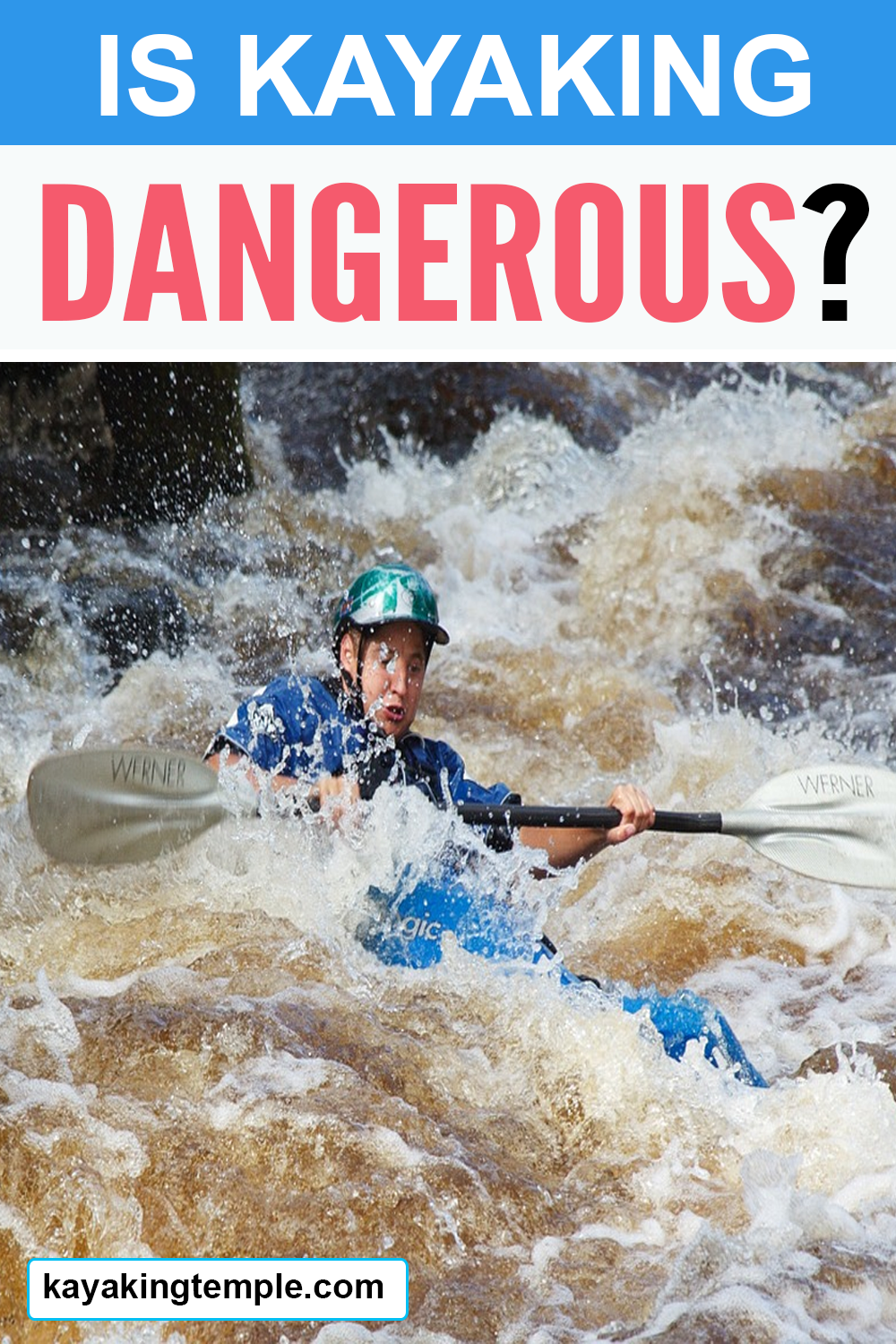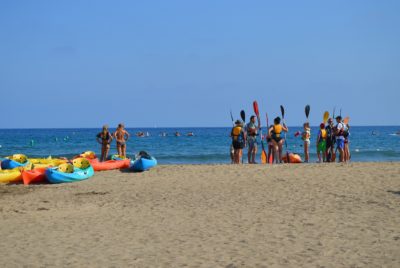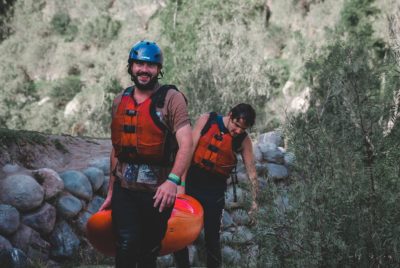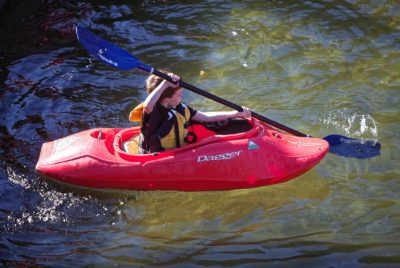Is Kayaking Dangerous?
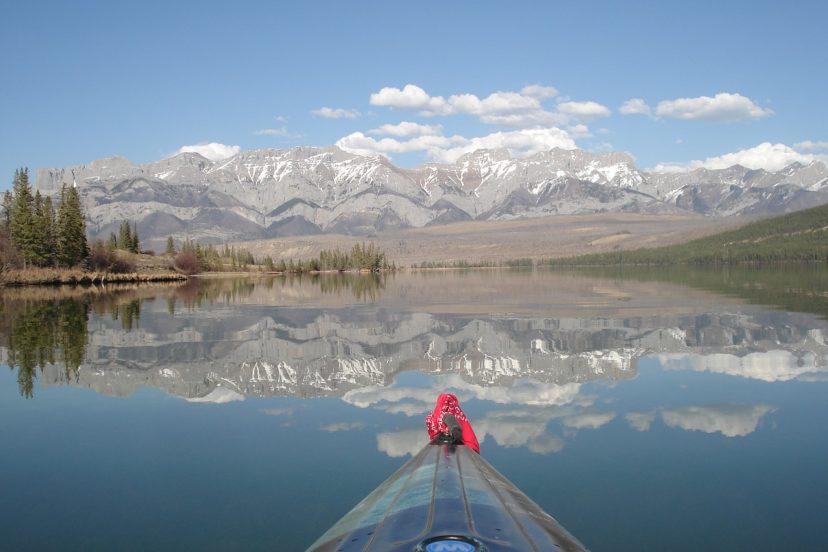
Many people want to know about the safety of kayaking. While some completely unaware of the possible risks of watersports, others cringe in fear because of illusory dangers that do not pose any risk in real life.
Let’s be sincere. Is kayaking dangerous? There are lots of factors to consider before giving an objective answer to the question. First let’s take a look at the difference between actual risks and merely perceived dangers.
Comparing potential risks and perceived dangers
It can be hard for people to give a correct estimate of how dangerous something is. Often people either take possible fatalities lightly, or they make a mountain out of a molehill. For instance, your grandmother may think that traveling abroad is highly risky, while a teenager would happlily travel internationally. The perception of dangers and risks is personal. And in most cases, such views aren’t based on established facts.
The perceived danger of kayaking on a flat-water body such as a lake would likely be small. And in reality it is low. On the other hand, the potential risk of kayaking in Class V rapids is high. The perceived danger is also quite high for most people.
Safety issues can become a factor when the potential risk and the perceived risks do not match with each other. It leads to a situation where people would think a situation is safe, but in fact, it carries a high risk. So, knowing the potential risk of an action is important. It allows you to prepare adequately for emergency situations.
Can a Kayak flip over?
Well, this is a good question. I was wondering about the same question when I started kayaking too. I remember having a mixed feeling, thinking that what if the kayak flipped over and I couldn’t turn it back.
Well, the answer to that question is that kayaks do not flip over easily because of the unique design they have. However, the chance of your kayak flipping over depends on the type of kayak and the kind of water you intend to paddle on.
For instance, it is almost impossible to flip when you are paddling on a relatively calm water body using a recreational kayak. On the other hand, the tendency of flipping your kayak is high when you are on rapid water (whitewater) using a sea kayak or an ultralight kayak.
Can I drown when my kayak turns upside down?
The chances of drowning when the kayak turns upside-down is low. However, you have to know the technique of exiting your kayak when it’s in an upside-down position. That is why you should take the time to study what to do when your kayak capsizes.
It is an excellent idea to enroll for a beginner’s course at a kayak club. They will teach you the basic steps you should know to use your kayak safely and enjoy your outdoor adventure.
What if I can’t swim? Should I still go Kayaking?
I have been asked this question several times, and my answer has always been the same. It is too risky for a non-swimmer to embark on the ocean or white-water kayaking. However, if the tide is slow and the water is calm, you can go kayaking even if you can’t swim. Just make sure you don’t venture too far from the bank. Besides that you need to fulfill the following requirements.
Wear a Live Jacket: According to marine law, you are required to wear a PFD (personal floatation device) every time you are kayaking. If you get a high-quality PFD, it will have many adjustment features that allow it to fit well and make you comfortable. This device prevents you from drowning even if you tip in. However, doublecheck to make sure they fit properly.
Don’t Be Scared: There is a tendency for people with strong aquaphobia to panic when they tip in. The fear may cause them to act irrationally, which may put them and other kayakers at risk. Therefore, people who have a tendency to panic inside the water should first do a tryout in a pool or slow-moving river, using a PFD. This trial will give you confidence that the PFD will keep you safe in water.
5 Potential Dangers while Kayaking
Cold Shock and Hypothermia
The cold water seems to be harmless when you are kayaking on it. However, you can be at risk of cold shock and hypothermia if you capsize into it. The water temperature could be freezing cold, even if the air outside is not.
When you fall in, the sudden change in environmental temperature affects your body. It can cause symptoms like breathing problems, blood pressure changes, and confusion. This state is called cold shock. The condition can be worse if you are in a water body with a strong current. You may not be able to get out of the water or respond to threats like getting smashed into a rock in the water.
When the human body is exposed to cold temperate over an extensive period of time, it leads to hypothermia. This usually occurs when a person is submerged in cold water. It can also occur if a person is not properly dressed and paddling in cold weather.
That is why you should always be properly dressed if you intend to paddle in cold water/weather. Wearing wetsuits and drysuits will help keep you safe and warm if you capsize.
It is wise not to paddle alone in cold water. Having someone to help when you experience cold shock can be a lifesaver.
Sun Exposure
Although going out to paddle on a quiet lake seems safe, it can quickly turn into a high-risk situation when the sun is out and hot. You might be okay to paddle in the sun for about an hour without sunscreen.
But it can quickly turn into a dangerous situation if you stay longer than an hour. Some of the risks of exposure to the sun over an extensive period of time include heatstroke, sunburn, heat exhaustion, and dehydration. Don’t think that paddling on will cool you down. In fact, it worsens the situation because the water will reflect the sunlight on your skin!
Strainer and Sweeper
Some of the dangerous objects you will encounter while paddling are strainers and sweepers. These are objects that are permeable to water but will not allow solids such as kayaks and people to pass-through.
These can be natural objects such as logs and tree branches or grates and rebar, which are deliberately installed. There is a risk of getting trapped underwater if you get entangled by one of these.
Sometimes trees and their branches fall into the water too. They can be a potential risk to paddlers when they are neither fully detached nor submerged.
Severe Weather Conditions
Every paddler needs to know that kayaking in extreme weather conditions is not a smart idea. However, there could be times when you are already out on the water and a storm starts. Showers won’t do any harm. But torrential rainfalls that are followed by lightning and thunder are dangerous while you are on the sea. In fact, it can lead to electrocution.
Undercut
The parts of the bank with hollow depressions under the water are called undercuts. These formations are often created by rock ledges or mud banks. Large undercuts can trap a submerged swimmer underneath a solid shelf beneath the water.
To make matters worse, undercuts are only visible under the water. So, victims only discover them when they are already in trouble. However, these formations are only common at river bends.
A Final Note
Kayaking is a cool way to have fun outdoors, connect with nature and share your time with friends and loved ones. However, you need to be mindful of some vital factors to enhance your safety.
Make sure your kayak and other equipment are in good condition. After that, make due diligence to research and choose an excellent location for your kayaking. Don’t forget to stick to all the essential safety measures.
Like This Article? Pin It On Pinterest
